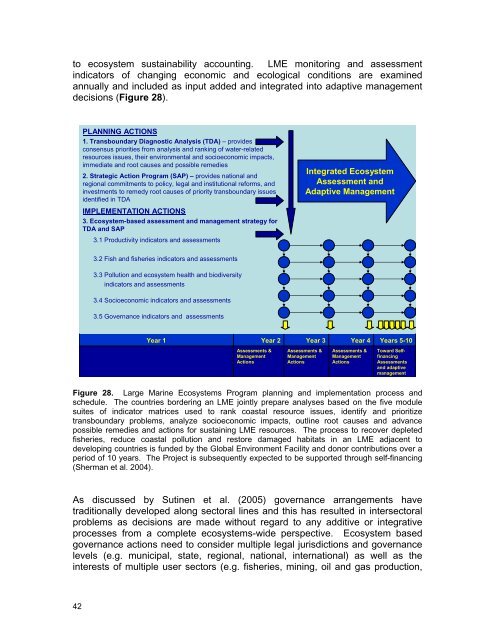Sustaining the World's Large Marine Ecosystems
Sustaining the World's Large Marine Ecosystems
Sustaining the World's Large Marine Ecosystems
You also want an ePaper? Increase the reach of your titles
YUMPU automatically turns print PDFs into web optimized ePapers that Google loves.
to ecosystem sustainability accounting. LME monitoring and assessment<br />
indicators of changing economic and ecological conditions are examined<br />
annually and included as input added and integrated into adaptive management<br />
decisions (Figure 28).<br />
42<br />
PLANNING ACTIONS<br />
1. Transboundary Diagnostic Analysis (TDA) – provides<br />
consensus priorities from analysis and ranking of water-related<br />
resources issues, <strong>the</strong>ir environmental and socioeconomic impacts,<br />
immediate and root causes and possible remedies<br />
2. Strategic Action Program (SAP) – provides national and<br />
regional commitments to policy, legal and institutional reforms, and<br />
investments to remedy root causes of priority transboundary issues<br />
identified in TDA<br />
IMPLEMENTATION ACTIONS<br />
3. Ecosystem-based assessment and management strategy for<br />
TDA and SAP<br />
3.1 Productivity indicators and assessments<br />
3.2 Fish and fisheries indicators and assessments<br />
3.3 Pollution and ecosystem health and biodiversity<br />
indicators and assessments<br />
3.4 Socioeconomic indicators and assessments<br />
3.5 Governance indicators and assessments<br />
Year 1<br />
Year 2<br />
Assessments &<br />
Management<br />
Actions<br />
Integrated Ecosystem<br />
Assessment and<br />
Adaptive Management<br />
Year 3<br />
Assessments &<br />
Management<br />
Actions<br />
Year 4<br />
Assessments &<br />
Management<br />
Actions<br />
Years 5-10<br />
Toward Selffinancing<br />
Assessments<br />
and adaptive<br />
management<br />
Figure 28. <strong>Large</strong> <strong>Marine</strong> <strong>Ecosystems</strong> Program planning and implementation process and<br />
schedule. The countries bordering an LME jointly prepare analyses based on <strong>the</strong> five module<br />
suites of indicator matrices used to rank coastal resource issues, identify and prioritize<br />
transboundary problems, analyze socioeconomic impacts, outline root causes and advance<br />
possible remedies and actions for sustaining LME resources. The process to recover depleted<br />
fisheries, reduce coastal pollution and restore damaged habitats in an LME adjacent to<br />
developing countries is funded by <strong>the</strong> Global Environment Facility and donor contributions over a<br />
period of 10 years. The Project is subsequently expected to be supported through self-financing<br />
(Sherman et al. 2004).<br />
As discussed by Sutinen et al. (2005) governance arrangements have<br />
traditionally developed along sectoral lines and this has resulted in intersectoral<br />
problems as decisions are made without regard to any additive or integrative<br />
processes from a complete ecosystems-wide perspective. Ecosystem based<br />
governance actions need to consider multiple legal jurisdictions and governance<br />
levels (e.g. municipal, state, regional, national, international) as well as <strong>the</strong><br />
interests of multiple user sectors (e.g. fisheries, mining, oil and gas production,









